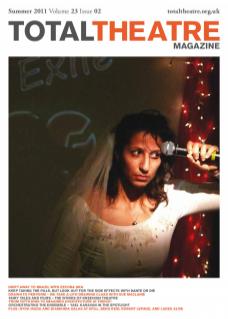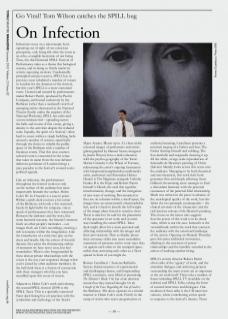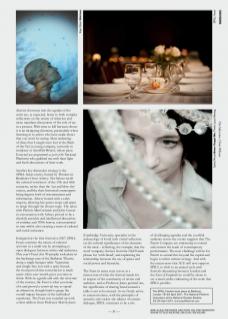Infections occur on a microscopic level, operating out of sight of our conscious perception, only being felt after the event as an echo, a tangible laceration of our being. Thus, the third biennial SPILL Festival of Performance takes as a theme this biological trauma, and in doing so firmly marks its artistic operating territory. Unashamedly principled and provocative, SPILL has in previous years inhabited a number of venues in London for the duration of the festival, but this year’s SPILL is a more contained event. Created and curated by performance-maker Robert Pacitti, produced by Pacitti Company, and hosted exclusively by the Barbican (other than a weekend’s worth of emerging artists showcased at the National Theatre Studio under the auspices of the National Platform), SPILL has cultivated a more intimate feel – spreading across the halls and rooms of this venue, giving a density to the activities despite the reduced scale. Equally, the spirit of a ‘festival,’ often hard to create within a single building, lurks around a number of corners, specifically through the choice to inhabit the public space of the Barbican with a number of breakout events. That this near countercultural event is ensconced in the venue that takes its name from the now defunct defensive perimeter of London brings a juicy paradox to the festival’s avowed socio-political agenda.
Like an infection, the performances throughout the festival work not only on the surface of the audience but more importantly beneath the surface. Helen Cole’s We See Fireworks is a case in point. Within a pitch-dark room in a far corner of the Barbican, with only a few scattered, barely-lit light bulbs for company, voices speak of performances they have witnessed. Between the darkness and the story, like some bacterial reaction, the listener’s memory feeds on other people’s memories – our images flesh out Cole’s recordings, creating a rich resonance within the imagination. Like the kinesthetics of a cold, they play on the chest and breath; like the echoes of feverish dreams, they paint the shimmering outline of moments we have never seen, but feel nonetheless. What is also foregrounded by these almost private relationships with the voices is the way your responses change when you’re joined by other audience members. In the half-dark there is a frisson of connection with these strangers who like you have stumbled upon this room of secrets.
Adjacent to Helen Cole’s work and echoing the second SPILL festival (2009) is the SPILL Tarot. This is a specially conceived Tarot deck fusing live art practices with the symbolism and mythology of the Tarot’s Major Arcana. Blown-up to A1, these richly coloured images of performers and artists (photographed by Manuel Vason; designed by Justin Weyers) have a dark coherence with the psycho-geography of the Tarot: Marisa Carnesky is the Wheel of Fortune, referencing the artist’s ongoing fascination with fairground paraphernalia; multimedia artist, performer and filmmaker Helena Hunter is The Magician; renegade Catholic Franko B is the Pope; and Robert Pacitti himself is Death, the card that signifies transformation, change, and the instigation of new ways of working. But mounted as they are on columns within a small space, the images have an unnecessarily claustrophobic feel, and it is hard to absorb the full weight of the image when forced to stand so close. There is much to be said for the placement of the spectator in art work and in some ways handling the actual SPILL Tarot deck might allow for a more personal and affecting relationship with the images and their provocations. Here as display pieces their existence shifts into more monolithic statements of presence and in some ways they vie against each other in the cramped space, rather than activating each other as a Tarot spread in front of you might do.
Romeo Castellucci / Societas Raffaello Sanzio, Italian maestros of experimental and challenging theatre, and long-standing SPILL associates, were billed as presenting The Minister’s Black Veil, but a late decision meant that they instead brought On the Concept of the Face, Regarding the Son of God to the Barbican. The show operates in a similar manner to Helen Cole’s work. Firmly in the camp of artists who resist categorisation or authorial meaning, Castellucci presents a minimal staging of a Father and Son: The Father shitting himself and sobbing, The Son dutifully and resignedly cleaning it up. All the while, a large-scale reproduction of Antonello de Messina’s painting of Christ (Salvator Mundi) looks across this scene into the audience. Managing to be both theatrical and anti-theatrical, this work feels both gossamer-thin and deeply affecting. Scott Gibbon’s thrumming score manages to find a discordant harmony with the personal resonances of the paternal-filial relationship. Much was written in the press in advance of the scatological quality of the work, but this belies the two principle counterpoints – the clinical environs of the ‘characters’ and the rich luscious colours of de Messini’s painting. This focus on the faeces also suggests that the power of this work is in its shock value, which is not the case. Instead it is the verisimilitude within the work that connects the audience with the emotional landscape of the action. Opening on Maundy Thursday gave this piece additional resonances, alluding to the inversion of powerrelationships and the humility encoded in the action of washing another being.
SPILL’s artistic director Robert Pacitti often talks of the ‘agency’ of work, and the attendant dialogue and archiving projects surrounding the main events are as important as the art work itself. These take a number of forms including SPILL TV (available on the website) and SPILL Talks, taking the form of curated interviews and dialogues. One medium of these talks is the CD interview stations, where contributing artists speak in response to the festival’s themes. These discrete doorways into the agenda of the artist are, as expected, home to both complex reflections on the nature of infection and more mundane discussions of the role of tea in a process. With time to kill between shows it is an intriguing diversion, particularly when listening in to artists who have made shows that you won’t be seeing. Most endearing of these that I caught were Get in the Back of the Van (a young company, currently in residence at Arnolfini Bristol, whose piece External was programmed as part of the National Platform) who grabbed me with their light and fresh discussions of their work.
Another key discussion strategy is the SPILL Salon events, hosted by Thinker-inResidence Oreet Ashery. The Salons recall the cultural ‘conclaves’ of the 17th and 18th centuries, rather than the ‘cut and blow dry’ variety, and like their historical counterparts bring degrees both of entertainment and information. Ashery hosted with a calm enquiry, allowing her guests scope and space to range through the chosen topic. The salon with Patricia MacCormack and John Cussan in conversation with Ashery proved to be a cheekily anarchic and intellectual discussion of zombies and 1950s horror, conversational in tone whilst also carrying a seam of cultural and social resistance.
Instigated at the first festival in 2007, SPILL Feasts continue the nature of cultural activism in a small way by attempting to open dialogues between artists and audiences. This year’s Feast (for 90 people) took place in the backstage area of the Barbican Theatre, along a single banquet table. Vegetarian and simple fare, but with a spicy thread, the food proved that conversation is much easier when your mouth gives you time to think. With no agenda and only the structure of the courses, the Feast is what you make of it and proved a convivial way to spend an afternoon, though hard to gauge the overall impact because of the individual experience. The Feast was rounded up with a short address from Professor Martin Jones (Cambridge University, specialist in the archaeology of food) with a brief reflection on the cultural significance of the elements of the meal – reflecting, for example, that the word ‘company’ derives from the Old French phrase for ‘with bread’, and explaining the relationship between the use of spices and social power and hierarchy.
The Feast in many ways serves as a microcosm of what the festival stands for in respect of the community of artists and audience, and as Professor Jones pointed out, the significance of sharing bread around a table is not to be missed. As we firmly arrive in uncertain times, with the principles of austerity and society the subject of current dialogue, SPILL continues to be a site of challenging agendas and the youthful audience across the events suggests that The Pacitti Company are continuing to extend and cement the reach of contemporary performance. The next challenge will be for Pacitti to extend this beyond the capital and begin to infect culture at large. And with the recent news that ACE will now support SPILL to shift to an annual cycle with festivals alternating between London and the East of England we could be about to see a much wider embracing of the work that SPILL profiles.
The SPILL Festival took place at Barbican, London 18–23 April 2011. The National Platform took place at the National Theatre Studios 23–24 April 2011. www.spillfestival.com


